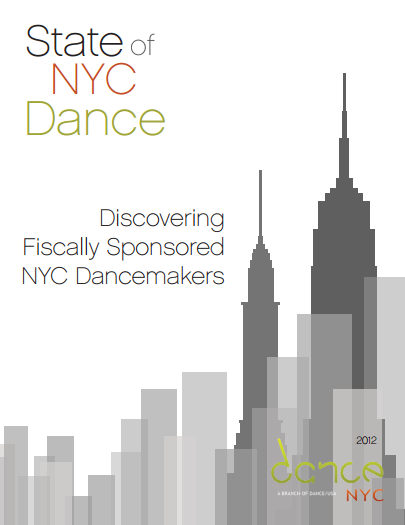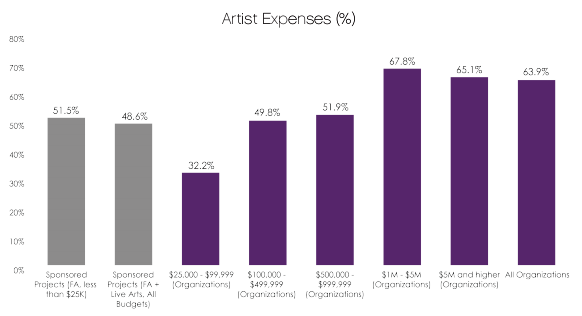That’s the title of a new study published this month by Dance/NYC and produced by yours truly, with (lots of) help from Fractured Atlas Research Fellow Carrie Blake and Dance/NYC Director Lane Harwell. The study examines data from over 250 dance-related projects fiscally sponsored by Fractured Atlas, The Foundation for Independent Artists/Pentacle, New York Foundation for the Arts, New York Live Arts, and The Field. Building off of Dance/NYC’s previously released research, “Discovering Fiscally Sponsored NYC Dancemakers” also compares findings where possible to corresponding figures for nonprofit dance organizations, as reported via the Cultural Data Project.
So what did we find? Not surprisingly, sponsored projects are for the most part quite small in scale. Aside from the Foundation for Independent Artists program, which is an unusual Model A full-service fiscal sponsorship that includes complete financial and payroll management, each fiscal sponsor’s projects averaged less than $16,000 in expenses for the most recently completed fiscal year. (Note that we had to work some statistical magic to get those figures from the available data, so they should be treated as estimates rather than hard counts. All relevant assumptions are included in the methodology section of the report.) It appears that in the New York dance world, at least, the grassroots level of the field is making heavy use of fiscal sponsorship.
According to figures self-reported by the sponsored projects, it also appears that the sponsored projects in the study group are more efficient than the corresponding nonprofits, by various measures. Compared to nonprofit dance organizations in all budget categories, sponsored projects spent the greatest share of their budgets on programs (83% vs. 72-83%), spent the least on fundraising for every dollar they raised (4 cents vs. 5-20 cents), and spent the least on marketing for every audience member they brought through the door ($0.28 vs. $0.53-$9.15). (The samples for these analyses varied according to which sponsors provided us with the relevant data; full details are in the report.) Furthermore, and perhaps most notably, the sponsored projects paid their artists proportionally more than nonprofits in the $25,000-$99,999 budget category: 48.6% to 32.2% of their budgets, respectively. Although the study was not designed to prove fiscal sponsorship’s value or lack thereof, it’s worth noting that these observations are consistent with one of the foundational theories behind fiscal sponsorship, which is that it saves small enterprises money and allows them to focus more of their energies on their programmatic work.
It should be noted that these findings come with some caveats. Most importantly, it’s difficult to know whether the differences noted above between the sponsored projects and the nonprofit organizations are more a function of corporate form or budget size. Due to the lack of representation of the smallest dance nonprofits in the Cultural Data Project, Dance/NYC had previously studied only nonprofits with budgets of $25,000 or more. By contrast, most of the fiscally sponsored projects under study had budgets falling under that amount. So we don’t know whether the sponsored projects seem more efficient because they don’t have to be nonprofits, or if there’s something about the under $25,000 budget range in particular that lends itself to greater efficiency – or both.
We are also dealing with incomplete samples for many of these analyses, due to the heterogeneity in data collection practices and standards among fiscal sponsors. The report includes a data collection comparison chart that details the overlaps and gaps between each sponsor’s data and the Cultural Data Project. Hopefully this resource can serve as a starting point for further collaboration.
Nevertheless, what “Discovering Fiscally Sponsored Dancemakers” does show is that fiscal sponsorship is a major force in the New York City dance world. Sponsored projects account for hundreds of distinct enterprises and at least $3 million in annual expenditures. They reach tens of thousands of audience members and serve something like a thousand artists (assuming a reasonable rate of overlap between projects). And remember, this is just in one discipline and one city of the country.
I hope more people will take advantage of the emerging data sets covering fiscally sponsored projects, one of the few windows we have into the poorly understood, creator-driven grassroots of the arts ecosystem. Fractured Atlas alone sponsors nearly 3,000 projects in all disciplines around the country, and we redesigned our annual report last year to better align with the CDP with exactly this sort of analysis in mind. The possibilities for better understanding our sector are just beginning to reveal themselves.
Further reading:
- Pia Catton, “The Nonprofit as Nonstarter,” Wall Street Journal
- Mike Keefe-Feldman, “NYC Dance Groups Eschew Nonprofit Model for Fiscal Sponsors,” Nonprofit Quarterly
- “Dance Groups Rethink Nonprofit Model, Report Finds,” Chronicle of Philanthropy
- Daniel Lehman, “For Dancers, Alternative Funding Model Replacing Non-Profits?” Backstage
- Alexandar Thompson, “Discovering Fiscally Sponsored NYC Dancemakers,” Live Arts Blog

